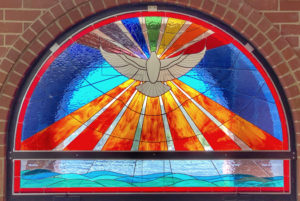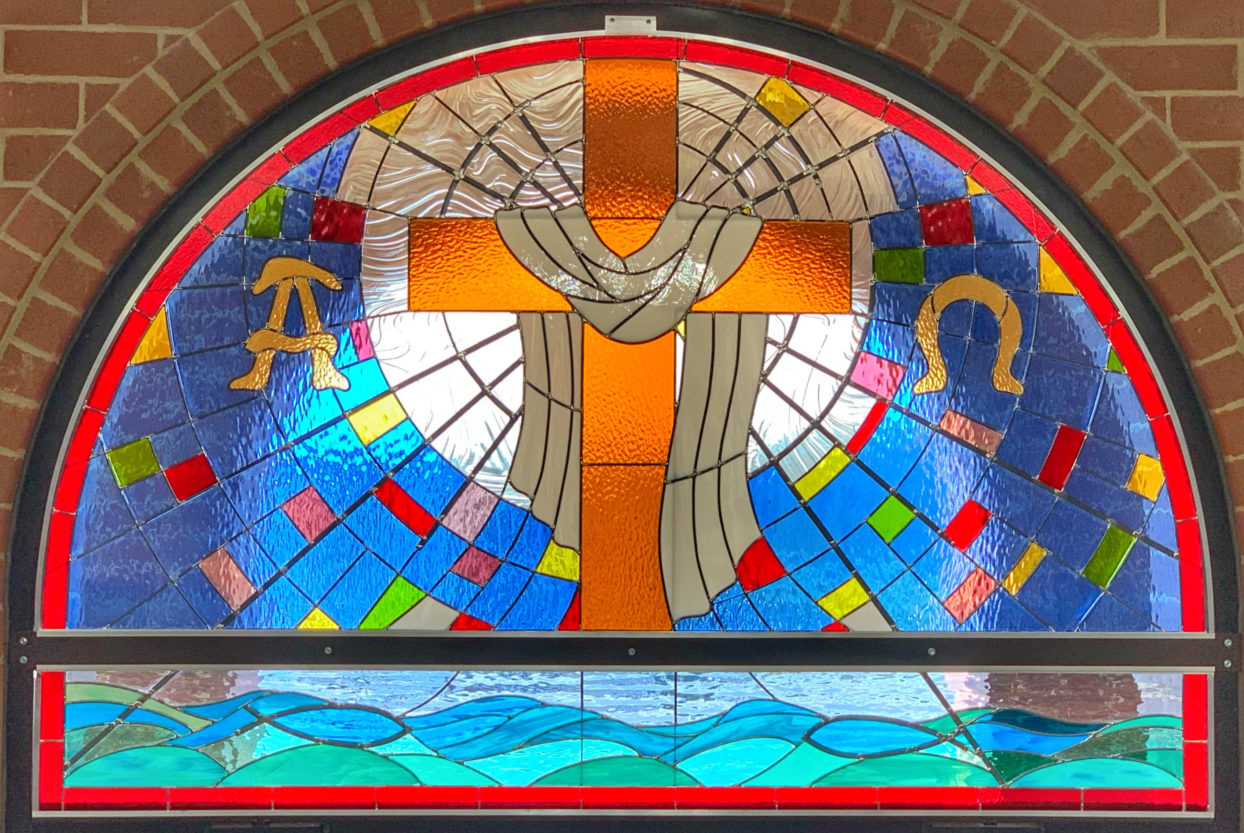By Mark Vallee
A few years back, I had the good fortune to spend some time with Father Manuel Pérez, pastor of St. Stephen Parish in Chattanooga, when Angela and I renewed our wedding vows.
After the ceremony in the St. Stephen chapel, we gave the attendees some stained-glass ornaments that we had made. Everyone could see the excitement in Father’s eyes as we stood in the lobby of the church. With great passion, Father Pérez asked if I would lead an effort to add more stained-glass windows to St. Stephen. Father Pérez is a hard person to say no to, so the process began.
The three blank window sections in the main entranceway of the church were selected by Father Pérez as the first stained-glass project. A location in the administration building was updated to include a working area for making stained-glass windows. Tools and supplies were acquired to complete a good work site. Father Pérez asked for volunteers, and a team was assembled. To prepare and train our volunteers, small panel windows were made for the rectory and door side-panel windows for the church main entrance.
The Trinity windows are unique to each dimension of God but also share elements of symbols, patterns and colors. Each window has an arched panel and a rectangular water scene as the door transom window. A red border surrounds each piece, similar to the glass behind the altar.
 Centered in each arched window is a cross structure or foundation for the Church. The volume of pieces used in each window reflects the activity volume in the Bible. There is white glass in or around the center of each window representing the purity of God.
Centered in each arched window is a cross structure or foundation for the Church. The volume of pieces used in each window reflects the activity volume in the Bible. There is white glass in or around the center of each window representing the purity of God.
The God the Father window has the most detail and number of pieces. The arched window symbolizes the Ark of the Covenant, the burning bush at Mount Sinai, and the all-seeing eye of God. The two angel figures look over the three contents of the Ark hidden in the burning bush. There are two tablets framed/outlined in lead, Aaron’s shaft with green shoots (the bushes center stock), and the gold bowl of manna between the arches of the tablets.
The burning bush center is glowing the brightest, signifying the voice of God speaking to Moses. There are 12 green leaves in the bush to represent the 12 tribes of Israel. The leaves are four shades of green to reflect the four wives/concubines of Jacob (Israel).
The pattern and color of the leaves are laid out directionally in the bush as the campsites for the tribes like a map with the top considered north. There are three streams of smoke rising off the burning bush representing the Trinity. The gray smoke rises up through the heavens past the seven stars that represent the seven days of creation. The smoke moves right through the red window border since God has no limits.
The transom window for God the Father is a water scene that displays the parting of the Red Sea. The red tornado clears and dries the path for God’s chosen people. This window is the start of the water motion for all the water windows. It displays a lot of physical energy.
The God the Son window is a celebration of Easter. The window is designed to show motion. Christ’s resurrection is mission complete. The dynamic impact is centered on the unoccupied cross. The cloth used to bring His body off the cross can’t be still. In the light you can see the shape of the cross through the white fabric.
The glass is cut and laid out in rings radiating out from the center of the cross like a pebble dropped in still water. With the cross becoming the impact zone, all the power is radiating outward. The waves get bigger and bigger as the impact of the resurrection grows. Six color chips are randomly placed in the background to reflect the six primary seasons of the Church, similar to the glass behind the altar.
The Greek symbols for the Alpha and Omega are placed to the left and right of the cross. In the glass around the cross there are also 12 rays similar to the glass behind the altar that represents the Twelve Apostles. Five of the rays touch the red border to show the five Apostles that were crucified to death on a cross.
 The water transom window for God the Son is not as rough as the parted seas. The water continues to lower and smooth out as it moves to the right. The seas hold a leaded shape of two fish and five loaves of bread in the colored waters.
The water transom window for God the Son is not as rough as the parted seas. The water continues to lower and smooth out as it moves to the right. The seas hold a leaded shape of two fish and five loaves of bread in the colored waters.
The God the Holy Spirit window has the fewest number of pieces. The intent of this window was to show a powerful strong image of the Holy Spirit descending upon us and delivering the seven gifts. In the daylight you can see the cross structure through the white dove.
The seven rays coming down from the Holy Spirit reflect the Pentecost colors of red and gold mixed in a dramatic blend. Shadow rings shaped like the Holy Spirit ripple out in three expanding rings. Over the Holy Spirit is the seven-color spectrum for the rainbow to represent God’s promise to never flood the world again.
The water transom window for God the Holy Spirit continues to lower as it moves to the right. The waves become smoother and longer, giving it a more peaceful feeling. The seven gifts of the Holy Spirit are etched into the sky over the water under each ray in the proper order.
Note: I am continuing this ministry by starting a new set of stained-glass windows in the sanctuary. Six arched windows will represent the Twelve Apostles.

